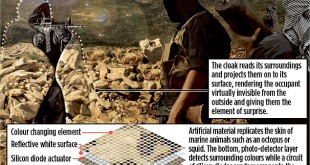Introduction: In the ever-evolving landscape of modern warfare, the ability to conceal military assets and personnel from adversaries has become increasingly vital. In the ever-evolving landscape of modern warfare, the quest for stealth and protection has driven relentless innovation in camouflage technologies. From troops on the ground to tanks and …
Read More »Smart Propulsion: How AI is Revolutionizing Marine Efficiency and Sustainability
The Challenge: Meeting Emissions Targets While Cutting Costs The global shipping industry is at a critical juncture. The International Maritime Organization’s (IMO) 2050 zero-emission target is fast approaching, and the looming implementation of carbon pricing mechanisms will fundamentally change the economics of maritime transport. For shipowners and operators, this creates …
Read More »DARPA’s SYNC Program: Rewriting Undersea Warfare with “Orthogonal” UUV Defenses
The Stealth Threat in Our Harbors Unmanned Undersea Vehicles (UUVs)—ranging from low-cost reconnaissance drones to armed “kamikaze” systems—are fast becoming one of the most asymmetric threats to U.S. maritime infrastructure. Adversaries use these quiet, stealthy platforms to mine harbors, spy on naval bases, or sabotage undersea assets with near impunity. …
Read More »DARPA’s SHIELD Program: Revolutionizing Combat Medicine Through Infection Immunotherapy
Bloodstream infections (BSIs) remain one of the deadliest complications in trauma care—particularly in combat environments where gunshot wounds, burns, and blast injuries create the ideal conditions for bacterial and fungal pathogens to thrive. Traditional treatments rely on pathogen identification and delayed antibiotic administration, a reactive model that often proves fatal …
Read More »The Quiet Revolution: How Wearable Brain Imaging is Rewriting Neuroscience
Imagine a toddler gleefully stacking blocks while wearing a colorful helmet, completely unaware she’s offering scientists the clearest picture ever captured of her developing brain. This isn’t a scene from a sci-fi movie—it’s today’s reality, made possible by a seismic shift in neuroimaging powered by wearable technologies. The age of …
Read More »The Digital Vanguard: How Military Logistics Transformation is Redefining Modern Warfare (2025 Update)
The New Battleground: Logistics in the Age of Strategic Competition Military logistics is no longer the quiet background function of warfare—it has become the algorithmic battlespace where wars are increasingly won or lost. As near-peer conflicts intensify and supply lines face unprecedented cyber and kinetic threats, armed forces are undergoing …
Read More »The Energetic Materials Revolution: Powering Hypersonic Warfare and Geopolitical Dominance in 2025
Introduction: The New Era of Energetic Superiority In today’s era of rapidly evolving warfare and strategic competition, energetic materials—including explosives, propellants, and pyrotechnics—have emerged as silent enablers of technological and geopolitical power. Far beyond their traditional roles, these compounds are now at the heart of innovations in hypersonic propulsion, AI-optimized …
Read More »India Forges Digital Shield: National Cyber Defense Blueprint Unveiled
New Delhi, India – In a significant stride toward securing the nation’s digital future, the Government of India has unveiled an ambitious national cyber defense blueprint, anchored in the capabilities of the Indian Cybercrime Coordination Centre (I4C). With cyberattacks becoming increasingly sophisticated, frequent, and transnational, the new framework represents a …
Read More »The New Technology Arms Race: Global DARPA-Inspired Agencies Take Shape
DARPA’s enduring legacy stems not just from its breakthrough technologies—like the Internet, GPS, and stealth aviation—but from a culture that marries autonomy, speed, and tolerance for failure. Around the world, nations are attempting to mirror that model. While some have made impressive gains, few have duplicated DARPA’s unique innovation …
Read More »Securing the Skies: 2025 Avionics Cybersecurity in the Era of Connected Flight
Avionics are the electronic systems used on aircraft. Aircraft avionics is the most crucial component of aircraft systems and helps in providing various operational and virtual information in-flight and on the ground. The avionics system receives data from the air traffic management system and feeds this information to the pilot …
Read More » International Defense Security & Technology Your trusted Source for News, Research and Analysis
International Defense Security & Technology Your trusted Source for News, Research and Analysis


